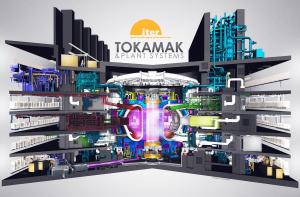A jewel in its concrete box
21 Jul 2014
-
R.A.
The "simplified models" that Lauris Honoré creates from the huge ITER data bank are terrific pedagogical and communication tools, revealing what the installation is really like, in all its beauty and complexity.
Deep into the ITER servers lies a huge data bank, constantly updated, that forms the 3D blueprint of the whole installation. Digging into this "detailed model", one can create ultra-precise renditions of any part of the machine, systems or buildings — down to the smallest pipe, nut and bolt.
Not everybody, however, needs such a high level of detail. A designer working on, say, in-wall shielding or assembly tooling, needs to have a clear picture of the environment his components will fit in — but not necessarily with the resolution the "detailed model" can provide.
What he needs is 3D data that is sufficiently detailed but light enough to be handled by his workstation. What he needs is something simplified. And Lauris Honoré, a young designer who's been with ITER for six years already, is here to provide it.
Simplified models have a value that reaches well beyond the technical needs of ITER. They are terrific pedagogical and communication tools, revealing what the installation is really like, in all its beauty and complexity.
Lauris has developed a talent for these spectacular, colourful renditions. "I add texture, colours, brilliance, put a little man here and there to give a sense of scale... the drawing must be both technically impeccable and visually pleasing."
The Tokamak Complex rendition that we publish today (a much reduced version of the original) is a perfect illustration of this approach: here's the heart of the installation, densely packed with systems and devices — a fabulous machine and encased in concrete like a jewel in its box.


